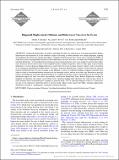| dc.contributor.author | Drake, Henri F | |
| dc.contributor.author | Ferrari, Raffaele | |
| dc.contributor.author | RUAN, XIAOZHOU | |
| dc.date.accessioned | 2023-02-15T14:55:20Z | |
| dc.date.available | 2023-02-15T14:55:20Z | |
| dc.date.issued | 2022 | |
| dc.identifier.uri | https://hdl.handle.net/1721.1/148073 | |
| dc.description.abstract | <jats:title>Abstract</jats:title>
<jats:p>Small-scale mixing drives the diabatic upwelling that closes the abyssal ocean overturning circulation. Indirect microstructure measurements of in-situ turbulence suggest that mixing is bottom-enhanced over rough topography, implying downwelling in the interior and stronger upwelling in a sloping bottom boundary layer. Tracer Release Experiments (TREs), in which inert tracers are purposefully released and their dispersion is surveyed over time, have been used to independently infer turbulent diffusivities—but typically provide estimates in excess of microstructure ones. In an attempt to reconcile these differences, Ruan and Ferrari (2021) derived exact tracer-weighted buoyancy moment diagnostics, which we here apply to quasi-realistic simulations. A tracer’s diapycnal displacement rate is exactly twice the tracer-averaged buoyancy velocity, itself a convolution of an asymmetric upwelling/downwelling dipole. The tracer’s diapycnal spreading rate, however, involves both the expected positive contribution from the tracer-averaged in-situ diffusion as well as an additional non-linear diapycnal distortion term, which is caused by correlations between buoyancy and the buoyancy velocity, and can be of either sign. Distortion is generally positive (stretching) due to bottom-enhanced mixing in the stratified interior but negative (contraction) near the bottom. Our simulations suggest that these two effects coincidentally cancel for the Brazil Basin Tracer Release Experiment, resulting in negligible net distortion. By contrast, near-bottom tracers experience leading-order distortion that varies in time. Errors in tracer moments due to realistically sparse sampling are generally small (< 20%), especially compared to the <jats:italic>O</jats:italic>(1) structural errors due to the omission of distortion effects in inverse models. These results suggest that TREs, although indispensable, should not be treated as “unambiguous” constraints on diapycnal mixing.</jats:p> | en_US |
| dc.language.iso | en | |
| dc.publisher | American Meteorological Society | en_US |
| dc.relation.isversionof | 10.1175/JPO-D-22-0010.1 | en_US |
| dc.rights | Article is made available in accordance with the publisher's policy and may be subject to US copyright law. Please refer to the publisher's site for terms of use. | en_US |
| dc.source | American Meteorological Society (AMS) | en_US |
| dc.title | Diapycnal displacement, diffusion, and distortion of tracers in the ocean | en_US |
| dc.type | Article | en_US |
| dc.identifier.citation | Drake, Henri F, Ruan, Xiaozhou and Ferrari, Raffaele. 2022. "Diapycnal displacement, diffusion, and distortion of tracers in the ocean." Journal of Physical Oceanography. | |
| dc.contributor.department | Massachusetts Institute of Technology. Department of Earth, Atmospheric, and Planetary Sciences | en_US |
| dc.relation.journal | Journal of Physical Oceanography | en_US |
| dc.eprint.version | Final published version | en_US |
| dc.type.uri | http://purl.org/eprint/type/JournalArticle | en_US |
| eprint.status | http://purl.org/eprint/status/PeerReviewed | en_US |
| dc.date.updated | 2023-02-15T14:47:40Z | |
| dspace.orderedauthors | Drake, HF; Ruan, X; Ferrari, R | en_US |
| dspace.date.submission | 2023-02-15T14:47:43Z | |
| mit.license | PUBLISHER_POLICY | |
| mit.metadata.status | Authority Work and Publication Information Needed | en_US |
